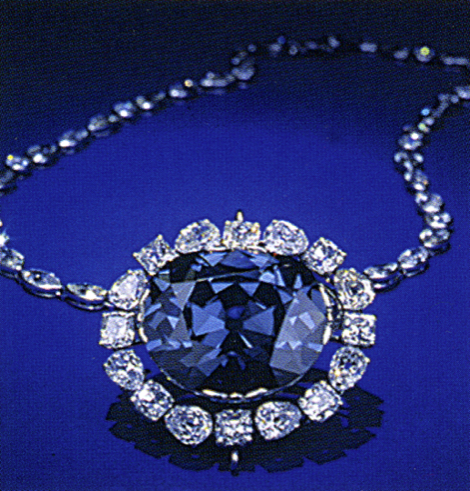
A Dog with Diamonds? An intriguing curse? A miserable queen?
Could so much adventure be wrapped up in the Hope Diamond?
This may sound like a storyline for Raiders of the Lost Ark, except this all involves one very famous gemstone called the Hope Diamond. It is an extraordinary deep blue color and weighs 45.53 carats.
It was brought from India to Europe in the 17th century, when it was known as the Tavernier Blue and sold to King Louis XIV of France. It came to be considered bad luck for all its subsequent possessors, including Maria Antoinette, Lord Francis Hope, and later American aristocrat Evelyn Walsh McLean.
Its origins are mysterious
The deep blue stone wasn’t known as “The Hope Diamond” until the 20th century, and its journey around the globe has only added to its mystique and legend. The Tavernier Blue Diamond, the entire 115 carat stone from which the Hope was likely taken, was a triangular stone.
A French merchant named Jean-Baptist Tavernier returned to Europe from his travels in India 1640 and 1667 with his magnificent treasure. One of the most interesting stories is that Tavernier may have pried it from one of the matching blue diamond eyes of a Hindu idol. As punishment for his great disrespect, the temple priests cast a terrible curse upon all who come into its possession.
In 1669, King Louis XIV of France bought the Tavernier Blue and had it cut down from its original 115 carats to about 67 carats. From that time it was called the Blue Diamond of the Crown, or simply “The French Blue.” At the urging of his wife, Marie Antoinette, King Louis XVI had the French Blue set into a more elaborate jeweled pendant for the Order of the Golden Fleece. Although she never actually wore it, Marie Antoinette is cited as one of the most famous victims of the curse. (Remember, she and her husband both lost their heads during the French Revolution).
In the 1800s it may have belonged to King George IV of the United Kingdom and touched his wife’s life with misery also, Caroline of Brunswick. Let’s just say her marriage was a disgrace, and death plagued her. Doesn’t she look very sad here?
Eventually, the name “The Hope Diamond” was given to it when it became part of a large gem collection owned by Henry Philip Hope. Evalyn Walsh McLean acquired the diamond in 1910 after Pierre Cartier dazzled her by placing the stone in a platinum setting surrounded by a row of sixteen alternating “Old Mine Cut” and pear-shaped diamonds.
Evalyn was the only daughter of an Irish immigrant who became a multimillionaire with the silver mines of Colorado. She married Edward Beale McLean in 1908 and became heir to the Washington Post and Cincinnati Enquirer publishing fortune.
A Diamond for the Dog
Although they divorced in 1929, Evalyn never parted with her “blue.” She wore the massive diamond as decoration on her gowns and swimsuits alike, whether she was appreciating art, attending concerts, or digging weeds in her garden. It even adorned her dog’s collar at parties. People who knew Evalyn said that she was always misplacing it, only to recruit friends and family into a game to find it. Her life was punctuated with flamboyance and sadness also, with her daughter’s tragic death.
McLean’s heirs sold it to Harry Winston, who in turn donated it to the Smithsonian Institution. Today the Hope Diamond is in the Smithsonian in the National Museum of Natural History, where millions of people visit it each year.
Photo: Courtesy of Thomasmichaels.com and Wickipedia.
Related articles:
http://learning.thomasmichaels.com/natural-color-diamonds-diamonds/natural-blue-color-diamonds
https://en.wikipedia.org/wiki/Hope_Diamond
https://www.aikenregional.com/community-information/aiken-history/aiken-and-the-hope-diamond





Leave a Reply